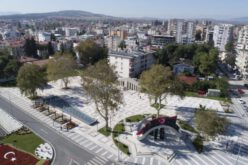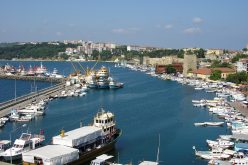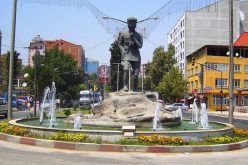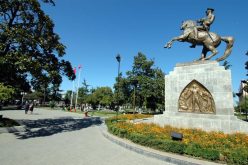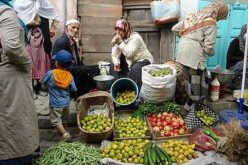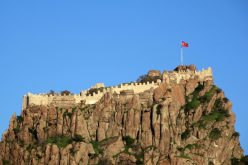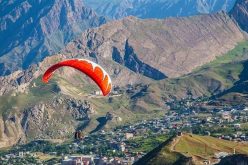Bursa
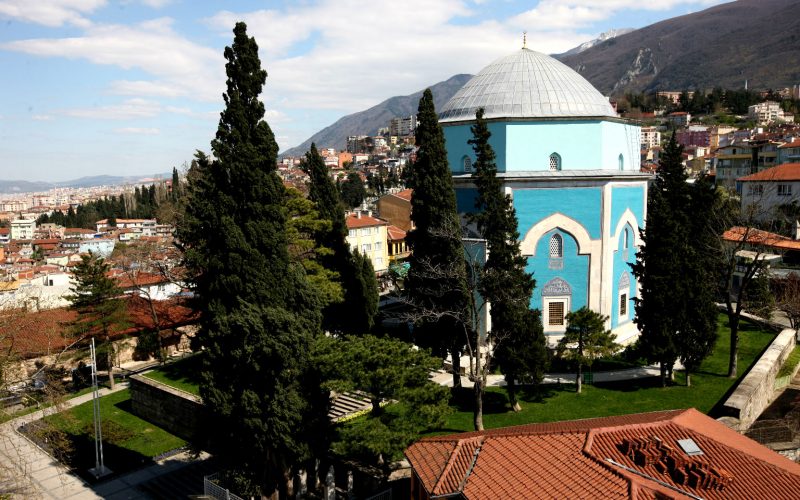
Bursa
Bursa lies in the northwestern part of Turkey near the Sea of Marmara, about 20 km inland. The Ottomans, who started as a small emirate in the countryside just east of Bursa,took control of their first major city, Bursa. As such, it served as the first capital city of the Ottoman Empire, from 1326, when it was captured from the Byzantines, to 1365, when the capital was moved to Edirne in European Turkey, as sultans started to turn their attention to Europe. Most of the historic sights of the city date back to this early period of the Ottomans. Today, with a population of more than 2,500,000, Bursa is the fourth largest city in Turkey after Istanbul, Ankara, and Izmir. It is famous for its peach, chestnut, and silk, although lately, heavy industry located in the outskirts of the city has surpassed these traditional industries. Furthermore, Uludağ—one of the highest mountains in Turkey—lies very close to Bursa and is the main winter sports center of Turkey.
Get in
By plane
An airport serving domestic and a couple of international flights can be found in Bursa (Yenişehir Airport, IATA: YEI, ICAO: LTBR). However, in order to get to Bursa from most countries by plane, you will have to take a transit flight via one of Turkey’s international airports. Istanbul’s Atatürk and Sabiha Gökçen are the nearest major international airports, and with a ferry connection, form the most common way of getting to the city. There are several international and domestic flights to Bursa.
Domestic
Operated by Anadolu Jet
Adana Şakirpaşa Airport
Diyarbakır Airport
Erzurum Airport
Samsun Çarşamba Airport
Sivas Airport
Trabzon Airport
By train
There is no railway in and around Bursa. However, when coming from Ankara, you can take the high-speed train (YHT) to Eskişehir, which is located about the mid-way, and then transfer to the bus heading for Bursa there, which is provided by Turkish State Railways and departs right in front of the station. This combined trip takes around 4 hours (as opposed to 5 and a half hours by bus only), and there are seven fast train departures daily from Ankara.
By car
Highways that are fairly wide and in good condition connect the city to north (D575/E881, from Izmit, Yalova, and Istanbul, the shortest route from last of which involves taking a ferry to Yalova), west (D200/E90 from Balıkesir with a connection to D565 from Izmir in the southwest), and east (D200/E90 from Eskişehir and Ankara, with a connection to D650 from Antalya in the south).
By bus
Buses from Istanbul take at least 3 hours to reach Bursa but the trip can take over 4 depending on the traffic. Note that the main Istanbul bus station (Otogar) can be a bit overwhelming with many companies on site and no central office; rather it is easiest if you know which company you want to travel with when you arrive and then find their offices. You can see the tickets to Bursa from anywhere in Bursa-Tikobilet. Many companies have buses leaving every hour or even half hour including Kamil Koc, Metro, Pamukkale, and Nilufer. There are bus services from all major cities to Bursa such as Istanbul, Ankara, Izmir and Antalya. Prices vary from 10 to 50 Euros based on the distance. All intercity buses will leave you at the very modern Terminal Bus Station about 10kms outside the city on the Istanbul motorway. Take the very frequent turquoise coloured mini buses marked ‘HEYKEL’ which will let you off right in the centre of Bursa opposite Ulucamii or the Great Mosque (or alternatively you can take the yellow bus 38 from the terminal into downtown – to return to the bus terminal get on the same bus going in the same direction, as #38 goes in a loop between downtown and the bus terminal.
By boat
There are two main options from Istanbul: The ferries operated by BUDO run from Kabataş directly opposite the tramway terminus to Mudanya. Take the M1 bus from Mudanya to the Emek metro station, and then to one of the city metro stops from there. If you are near Sultanahmet, and can find your way to the terminal through the foreshore renovations on foot, you can take the Yenikapı-Bursa car ferry from Istanbul Yenikapı terminal (in the European part of Istanbul near Sultanahmet) to Güzelyalı (80 minutes ). Güzelyalı is about 20km from Bursa so buses meet the ferry to take passengers to Organize Sanayi metro station (30mins ) in the outer suburbs of the city. Take the metro to downtown Bursa – get off at Şehre Küstü station for the old section of the city close to the market area (30mins ). The whole journey from Istanbul to the centre of Bursa will take about 2.5 to 3 hours. It’s also possible to transit through Yalova fast ferry jetty, about an hour bus ride north of Bursa. The ferries operated by IDO can leave from Yenikapı, Kabataş, or Kadıköy. Tickets can be booked online, but only if you have a Turkish phone number.
Get around
The city has a metro line connecting downtown with suburbs in the northwest. There is also an extensive bus and dolmuş (dolmus) network. The dolmuşes in Bursa are more likely to be a normal looking white car with a sign on the roof rather than the yellow minibuses that are common in Istanbul. The Bursa Metro is called Bursaray – for information in Turkish: Bursaray and a map
For extensive bus lines visit BURULAŞ (Burulas)
See
Mosques
Ulucami, (in downtown). The “great mosque” of Bursa. Built in early Ottoman period, in 1399, it resembles more of earlier Seljuq buildings of inland Anatolia than the typical Ottoman mosques such as Blue Mosque of Istanbul built later. Ulucamii is perhaps most re known for the striking calligraphic panels that adorn its walls and columns as well as the fountain within the mosque whose trickling sounds contribute to its serene atmosphere.
Orhan Camii ve Külliyesi (Orhan Mosque)
Yeşil Camii (Green Mosque)This mosque is in the Yesil or ‘green’ district of Bursa just left over the bridge. It contains a wonderful Turbe or tomb completely covered by tiles inside and out. The mosque opposite is very unusual in that it has a fountain inside the prayer area – with lots of legends attached to it. It is also built in a cruciform shape. No one knows why. Beside it are tea gardens with spectacular views over the Bursa valley and Uludag mountain.
Emir Sultan Camii
Muradiye Camii
Hüdavendigar Camii
Yıldırım Camii
Koca Sinan Paşa
Ishak Paşa Külliyeleri
Celal Bayar Müzesi
Tombs
Yeşil Türbe(Green Tomb) is the tomb of the Ottoman Sultan Mehmed I (1412-1420) and is the iconic monument of the city.
Emir Sultan Türbesi
Gazi Timurtaş Paşa Türbesi
Gazi Osman Türbesi is the tomb of the first Ottoman sultan located in the Tophane district
Orhan Gazi Türbesi is the tomb of the second Ottoman sultan, the son of Osman. It’s located immediately next to his father’s tomb in the Tophane district.
The Muradiye Complex surrounding the Muradiye Mosque is a small necropolis filled with tombs of illustrious Ottoman figures such as Murat II; Prince Mustafa, son of Suleiman the Great; Gülbahar Hanım, midwife of Mehmet the Conqueror and various wives of sultans.
Museums
Museum of Turkish and Islamic Art, (Part of Yeşil Camii complex). Jewelry boxes, vases and pottery, belts an, accessories and clothes, tools, manuscripts, and more. Small, but free museum is worth seeing if you are already at at Yeşil Camii and Yeşil Türbe.
Bursa Archeology Museum.
Bursa Immigration History Museum.
Bursa City Museum.
Forest Museum.
Health Museum.
Tofaş Anatolian Cars Museum.
Cumalıkızık Ethnography Museum.
Hünkâr Köşkü.
Historical Trees
Inkaya — a huge centuries-old (well, approximately 600 years, to be precisely) plane (Platanus orientalis) tree with an open-air café sheltered by its deep shadow, on the foothills of (and just off the road to) Uludağ.
Historical Buildings
Darüzziyafe. A poorhouse during the Ottoman period, this building now serves as a family restaurant (with no alcohol service).It is a stunningly restored building in the Muradiye district of Bursa. The garden has wonderful views of Bursa. The cuisine is pure Ottoman and difficult to find in a modern Turkish city.
Sarı Konak In Tophane.
Balıbey Han
Koza Han
Irgandı Köprüsü (Bridge)in Setbasi. Its an old version of shopping malls.There are small shops on bridge.
Old villages
Cumalıkızık A village founded more than 700 years old. There are 265 centuries-old half timbered houses in the village and approximately 190 of them are still occupied.
Do
Yeni Kaplica (Termal Hotel and Baths), Kukurtlu Mh. Cekirge Cad (Immediately down from the Celik Palas Hotel), ☎ 0224 2366968, . An experience not to be missed while visiting Bursa for anyone interested in a relaxing thermal bath. The mineral water boils up from below the extensive baths built in 1555 and flows into a large central pool from a lion’s head fixed into the wall. The baths are anything but touristy but the staff are used to tourists. Not a word of Turkish is necessary! The building remains unchanged since it was built by the Vezir ‘Kara Mustafa’ or ‘Black Mustafa’. It is a large multi roomed building with a wonderful sense of space and proportion. it is modeled on the Roman Baths rather than a hamam as pools – or non-flowing water were never permitted under Islam. This is the exception. A good rub down (kese) and a massage are essential. Afterwards just go for a nap in one of the beds provided wrapped in towels.
Turkish Baths
Since Bursa lies on a geologically-active area and Uludağ mountain is an extinct volcano, the place is very rich in mineral waters and accordingly is famous for its traditional baths.
Keçeli Hamamı. For women. More than 600 years old and renewed.
Umurbey Hamamı
Yeşil Hamamı
Beyaz Saray Hamamı. For men. In Altıparmak.
Kervan Saray Hamamı For Women and For Men ,in Cekirge district. The Hamam has a nice pool.Its so clean and hygienic.
Write a Comment
Only registered users can comment.




